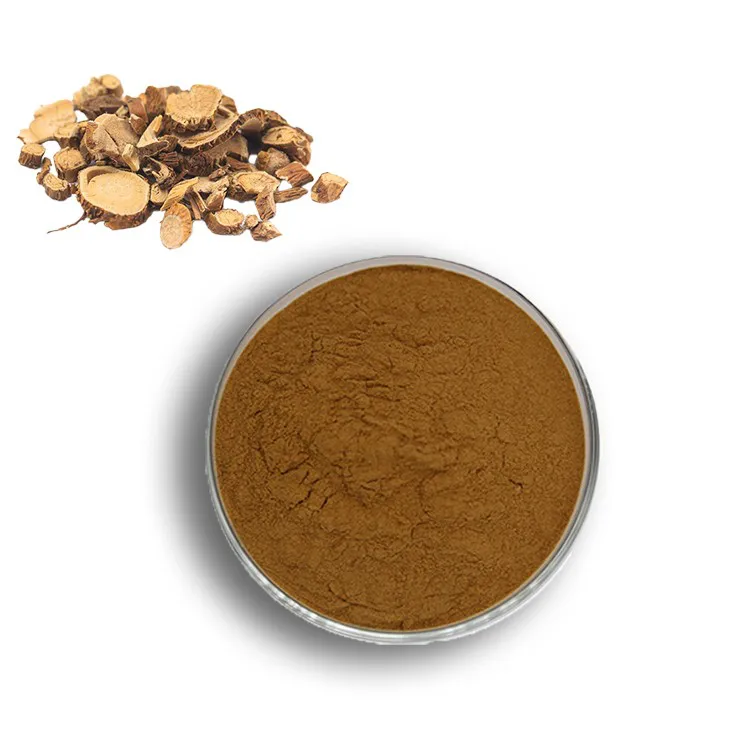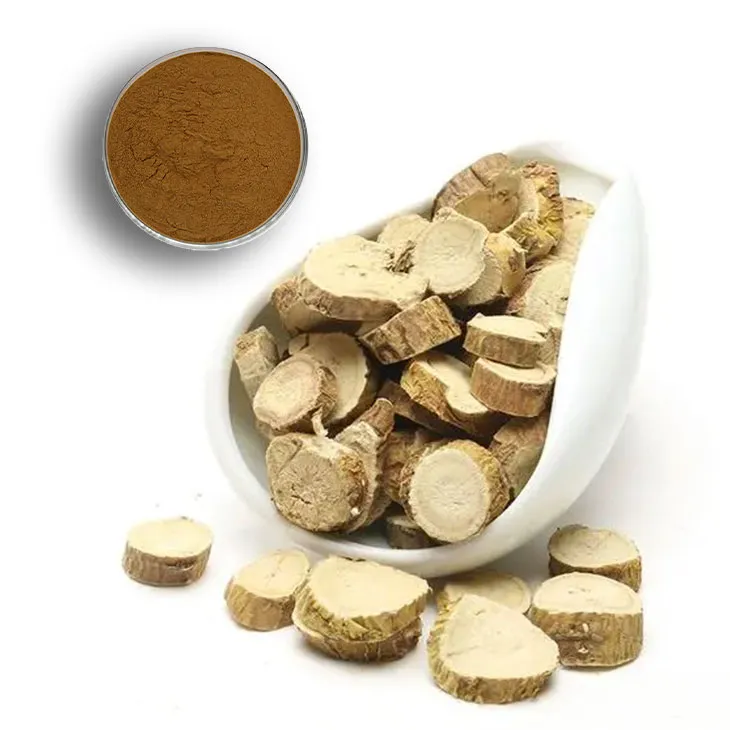- 0086-571-85302990
- sales@greenskybio.com
The Most Highly - Praised Sophora Flavescens Root Extract.
2024-11-30

Introduction to Sophora Flavescens Root Extract
Sophora Flavescens Root Extract has been highly regarded in various fields due to its remarkable properties. It is derived from the root of the Sophora flavescens plant, which has a long history of use in traditional medicine.

Skin - Related Benefits
Skin Problem Soothing
One of the most prominent uses of Sophora Flavescens Root Extract is in the treatment of skin problems. Eczema and psoriasis are two common skin conditions that can be alleviated by this extract. It has the ability to regulate the skin's immune response. The skin's immune system plays a crucial role in maintaining skin health. When the immune response is imbalanced, it can lead to various skin disorders. Sophora flavescens root extract helps to bring this response back into balance, reducing inflammation and irritation associated with eczema and psoriasis.
Antioxidant Properties for Skin
As a natural antioxidant, Sophora flavescens root extract offers significant benefits for skin health. Oxidative stress can cause damage to skin cells, leading to premature aging, wrinkles, and a dull complexion. The antioxidant components in the extract scavenge free radicals, which are highly reactive molecules that can damage cells. By neutralizing these free radicals, the extract helps to protect skin cells from oxidative damage. This not only keeps the skin looking healthy and youthful but also helps in preventing various skin diseases that may be triggered by oxidative stress.

Role in the Pharmaceutical Industry
Drug Development Potential
In the pharmaceutical industry, Sophora flavescens root extract is attracting increasing attention. Researchers are exploring its potential in drug development. The plant contains a variety of unique chemical constituents. These constituents may hold the key to treating some difficult - to - cure diseases. For example, certain compounds in the extract may have anti - inflammatory, anti - microbial, or anti - cancer properties. By studying these components in detail, scientists hope to develop new drugs that can effectively treat a range of diseases.
Low Toxicity Advantage
Compared to some synthetic drugs, Sophora flavescens root extract has a relatively low toxicity. This is a major advantage in drug development. High - toxicity drugs often come with a range of side effects that can limit their use or cause harm to patients. The lower toxicity of Sophora flavescens root extract makes it a more attractive candidate for further study. It means that there is a greater potential for developing safe and effective medications based on this extract. However, it is important to note that further research is still needed to fully understand its safety profile and potential interactions with other drugs.

Traditional and Modern Research on Sophora flavescens Root Extract
Traditional Use in Herbal Medicine
For centuries, Sophora flavescens has been used in herbal medicine. In traditional medicine systems, the root extract has been used to treat a variety of ailments. It was often used topically for skin problems and internally for digestive and liver disorders. The knowledge of its medicinal properties has been passed down through generations, and it has become an important part of traditional herbal remedies in many cultures.
Modern Scientific Research
Modern scientific research has begun to unravel the mysteries behind the effectiveness of Sophora flavescens root extract. Using advanced techniques such as chromatography and spectroscopy, researchers have been able to identify and isolate the active components in the extract. These studies have provided a deeper understanding of how the extract works at the molecular level. For example, research has shown that certain flavonoids in the extract are responsible for its antioxidant and anti - inflammatory effects. This knowledge has paved the way for more targeted research and the development of new therapeutic applications.
Challenges and Future Directions
Quality Control and Standardization
One of the major challenges in the use of Sophora flavescens root extract is quality control and standardization. Since the extract is derived from a natural source, its composition can vary depending on factors such as the plant's origin, growth conditions, and extraction methods. This variability can affect its efficacy and safety. To ensure consistent quality, there is a need for strict quality control measures and standardization protocols. These should cover aspects such as the identification of active ingredients, purity, and potency of the extract.
Clinical Trials and Regulatory Approval
For Sophora flavescens root extract to be fully integrated into modern medicine, more clinical trials are needed. While there has been some pre - clinical research on its potential benefits, large - scale clinical trials are required to prove its effectiveness and safety in humans. Additionally, obtaining regulatory approval is a complex process. Regulatory agencies require extensive evidence of a product's safety and efficacy before it can be approved for medical use. Overcoming these hurdles will be crucial for the future development and acceptance of Sophora flavescens root extract - based medications.
Expanding Therapeutic Applications
There is also great potential for expanding the therapeutic applications of Sophora flavescens root extract. Current research has mainly focused on its use in skin health and drug development for certain diseases. However, there may be other areas where the extract could be beneficial. For example, it could potentially be used in the treatment of neurodegenerative diseases or autoimmune disorders. Future research should explore these potential applications and uncover new ways in which Sophora flavescens root extract can contribute to human health.
Conclusion
In conclusion, Sophora flavescens root extract is a highly promising natural product with a wide range of potential benefits. Its use in soothing skin problems and its antioxidant properties make it valuable for skin health. In the pharmaceutical industry, its unique chemical constituents and low toxicity offer great potential for drug development. However, there are still challenges to be overcome, such as quality control, clinical trials, and regulatory approval. With further research and development, Sophora flavescens root extract has the potential to make significant contributions to the field of medicine and improve human health in many ways.
FAQ:
What are the main benefits of Sophora flavescens root extract?
It has multiple benefits. In herbal medicine, it can soothe skin problems like eczema and psoriasis by regulating skin's immune response. It is also a natural antioxidant, protecting cells from oxidative damage. In the pharmaceutical industry, its unique chemical constituents may be useful for treating some hard - to - cure diseases and its relatively low toxicity makes it attractive for further drug development research.
How does Sophora flavescens root extract soothe skin problems?
It soothes skin problems such as eczema and psoriasis through its ability to regulate the skin's immune response. This regulation helps to address the underlying causes of these skin conditions.
Why is Sophora flavescens root extract considered as a natural antioxidant?
It contains certain substances that have antioxidant properties. These substances can prevent or slow down the oxidation process in cells, thus protecting cells from oxidative damage. This makes it a natural antioxidant.
What potential does Sophora flavescens root extract have in the pharmaceutical industry?
Its unique chemical constituents may have the potential to treat some difficult - to - cure diseases. Also, compared to some synthetic drugs, it has relatively low toxicity, which makes it a very promising candidate for further study and drug development in the pharmaceutical industry.
Is Sophora flavescens root extract safe to use?
Compared to some synthetic drugs, it has relatively low toxicity. However, like any substance, its safety also depends on proper usage, dosage, and individual factors. More research is still needed to fully understand all aspects of its safety.
Related literature
- The Pharmacological Properties of Sophora flavescens Root Extract"
- "Sophora flavescens Root Extract: A Promising Natural Substance in Medicine"
- "Antioxidant and Skin - Soothing Effects of Sophora flavescens Root Extract"
- ▶ Hesperidin
- ▶ citrus bioflavonoids
- ▶ plant extract
- ▶ lycopene
- ▶ Diosmin
- ▶ Grape seed extract
- ▶ Sea buckthorn Juice Powder
- ▶ Beetroot powder
- ▶ Hops Extract
- ▶ Artichoke Extract
- ▶ Reishi mushroom extract
- ▶ Astaxanthin
- ▶ Green Tea Extract
- ▶ Curcumin Extract
- ▶ Horse Chestnut Extract
- ▶ Other Problems
- ▶ Boswellia Serrata Extract
- ▶ Resveratrol Extract
- ▶ Marigold Extract
- ▶ Grape Leaf Extract
- ▶ blog3
- ▶ blog4
-
The best sources of natural pitaya powder.
2024-11-30
-
Organic Maca Extract Powder Supplier
2024-11-30
-
The Best Natural Source of Ivy Extract.
2024-11-30
-
Natural grape seed extract
2024-11-30
-
Citrus Aurantium Extract
2024-11-30
-
Citrus bioflavonoids
2024-11-30
-
Propolis Extract Powder
2024-11-30
-
Oat Straw Extract Powder
2024-11-30
-
Calendula Extract
2024-11-30
-
melatonin extract
2024-11-30
-
Saponin Extract
2024-11-30
-
Tamarind extract powder
2024-11-30
-
Resveratrol extract
2024-11-30





















